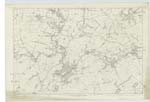OS1/3/37/13
| List of names as written | Various modes of spelling | Authorities for spelling | Situation | Description remarks |
|---|---|---|---|---|
| DOWNANS HILL | Downans Hill Downans Hill Downans Hill Dunans Hill Castle Downans Cassillis' Downans |
Revd [Reverend] John Mc Ewen Mr John Brown Mr William Hart Johnston's County Map Burns' Halloween |
039 | A Well known, Middling Sized, but prominent Hill. About 500 feet in height, with a Steep ascent on all Sides, particularly so at the South East Side, where there is a ridge of Steep Rocks immediately at the Summit & which forms a Natural battlement; it affords very good pasture, presents the form of a Cone when viewed at a distance, and, although comprising five little hills or knolls, on the whole has a very imposing aspect. - There is the remains of an Old British Camp or fortlet on the Summit of this hill and also a Trigl. [Trigonometrical] Station. Marquis of Ailsa Proprietor. - "In former times, Downans Hill was regarded as a favourite haunt of the fairies of Ayrshire, and a popular tradition exists illustrative of their peculiar Attachment to the locality. The House of Cassillis it is said, was Originally intended to have Occupied a Site on the top [continued on page 14] |
| CAMP (Remains of) [Downans Hill] | 039 | [See continued entries/extra info] |
Continued entries/extra info
[Page] 13Sheet 39 Plan 14 -- Parish of Kirkmichael
"The Cassillis Downans are five beautiful
"green little hills, about half a mile south from
" the house of Cassillis. ***There are traces of five British or
" Danish fortlets in this parish, two in the farm of Guiltreehill, one
" in Keonstan, one in Cassanton, and another in Castle Downans.
"They are all circular, and are supposed to belong to the early
" period of the fourteenth century. They are about a hundred yards in
" diameter, with a ditch of nearly fifteen feet wide; on being ploughed
" up, fragments of pitchers, spears, horns, ashes &c. are everywhere
" discovered." Statistical Account (1842).
"This must be a mistake for the fourth century, because,
"whether British or Danish, their era must be much earlier than
" the fourteenth century. There is every reason to believe, as the Roman
" road from Galloway to Ayr traverses the course of the Doon at no great
"distance, that they are British remains of the Roman period."
Pattersons History of Ayrshire (1847)
Transcribers who have contributed to this page.
Chr1smac -Moderator, Nellie- Moderator
Location information for this page.
Linked mapsheets.




